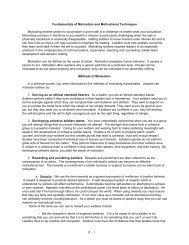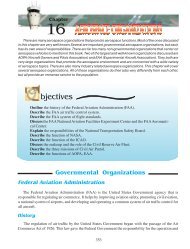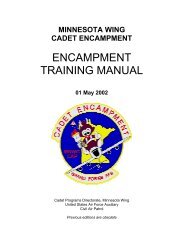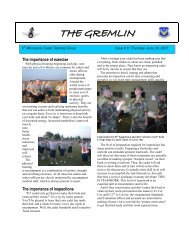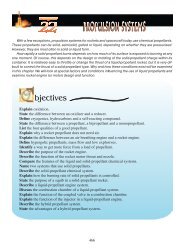Consequently, we do not restrict the type of collaborationnor the target problem. Rather, we view CS as a generalpurposeproblem-solving method. We say that a system isa CS system if it enlists a crowd of humans to help solve aproblem defined by the system owners, and if in doing so, itaddresses the following four fundamental challenges:How to recruit and retain users? What contributions canusers make? How to combine user contributions to solvethe target problem? How to evaluate users and their contributions?Not all human-centric systems address these challenges.Consider a system that manages car traffic in Madison,WI. Its goal is to, say, coordinate the behaviors of a crowdof human drivers (that already exist within the system) inorder to minimize traffic jams. Clearly, this system doesnot want to recruit more human drivers (in fact, it wantsfar fewer of them). We call such systems crowd management(CM) systems. CM techniques (a.k.a., “crowd coordination”31 ) can be relevant to CS contexts. But the twosystem classes are clearly distinct.In this survey we focus on CS systems that leverage theWeb to solve the four challenges mentioned here (or asignificant subset of them). The Web is unique in that itcan help recruit a large number of users, enable a high degreeof automation, and provide a large set of social software(for example, email, wiki, discussion group,blogging, and tagging) that CS systems can use to managetheir users. As such, compared to the physical world, theWeb can dramatically improve existing CS systems andgive birth to novel system types.Classifying CS systems. CS systems can be classifiedalong many dimensions. Here, we discuss nine dimensionswe consider most important. The two that immediatelycome to mind are the nature of collaboration andtype of target problem. As discussed previously, collaborationcan be explicit or implicit, and the target problemcan be any problem defined by the system owners (for example,building temporary or permanent artifacts, executingtasks). The next four dimensions refer respectivelyto how a CS system solves the four fundamental challengesdescribed earlier: how to recruit and retain users;what can users do; how to combine their inputs; and how toevaluate them. Later, we will discuss these challenges andthe corresponding dimensions in detail. Here, we discussthe remaining three dimensions: degree of manual effort,role of human users, and standalone versus piggyback architectures.Degree of manual effort. When building a CS system, wemust decide how much manual effort is required to solveeach of the four CS challenges. This can range from relativelylittle (for example, combining ratings) to substantial(for example, combining code), and clearly also dependson how much the system is automated. We mustdecide how to divide the manual effort between the usersand the system owners. Some systems ask the users to dorelatively little and the owners a great deal. For example,to detect malicious users, the users may simply click abutton to report suspicious behaviors, whereas the ownersmust carefully examine all relevant evidence to determineif a user is indeed malicious. Some systems do thereverse. For example, most of the manual burden of mergingWikipedia edits falls on the users (who are currentlyediting), not the owners.Role of human users. We consider four basic roles of humansin a CS system. Slaves: humans help solve the problemin a divide-and-conquer fashion, to minimize theresources (for example, time, effort) of the owners. Examplesare ESP and finding a missing boat in satellite imagesusing Mechanical Turk. Perspective providers: humanscontribute different perspectives, which when combinedoften produce a better solution (than with a singlehuman). Examples are reviewing books and aggregatinguser bets to make predictions. 29 Content providers: humanscontribute self-generated content (for example,videos on YouTube, images on Flickr). Componentproviders: humans function as components in the targetartifact, such as a social network, or simply just a communityof users (so that the owner can, say, sell ads). Humansoften play multiple roles within a single CS system(for example, slaves, perspective providers, and contentproviders in Wikipedia). It is important to know theseroles because that may determine how to recruit. For example,to use humans as perspective providers, it is importantto recruit a diverse crowd where each human canmake independent decisions, to avoid “group think.” 29Standalone versus piggyback. When building a CS system,we may decide to piggyback on a well-established system,by exploiting traces that users leave in that system tosolve our target problem. For example, Google’s “Did youmean” and Yahoo’s Search Assist utilize the search logand user clicks of a search engine to correct spelling mistakes.Another system may exploit user purchases in anonline bookstore (Amazon) to recommend books. Unlikestandalone systems, such piggyback systems do not haveto solve the challenges of recruiting users and decidingwhat they can do. But they still have to decide how toevaluate users and their inputs (such as traces in thiscase), and to combine such inputs to solve the targetproblem.34
SAMPLE CS SYSTEMS ON THE WEBBuilding on this discussion of CS dimensions, we nowfocus on CS systems on the Web, first describing a set ofbasic system types, and then showing how deployed CSsystems often combine multiple such types.The accompanying table shows a set of basic CS systemtypes. The set is not meant to be exhaustive; it shows onlythose types that have received most attention. From leftto right, it is organized by collaboration, architecture, theneed to recruit users, and then by the actions users cantake. We now discuss the set, starting with explicit systems.Explicit Systems: These standalone systems let users collaborateexplicitly. In particular, users can evaluate, share,network, build artifacts, and execute tasks. We discussthese systems in turn.Evaluating: These systems let users evaluate “items” (forexample, books, movies, Web pages, other users) usingtextual comments, numeric scores, or tags.10Sharing: These systems let users share “items” such asproducts, services, textual knowledge, and structuredknowledge. Systems that share products and services includeNapster, YouTube, CPAN, and the site programmableweb.com (for sharing files, videos, software, andmashups, respectively). Systems that share textual knowledgeinclude mailing lists, Twitter,how-to repositories (such asehow.com, which lets users contributeand search howto articles), Q&A Websites (such as Yahoo! Answers2), onlinecustomer support systems (suchas QUIQ, 22 which powered Ask Jeeves’AnswerPoint, a Yahoo! Answers-likesite). Systems that share structuredknowledge (for example, relational,XML, RDF data) include Swivel, ManyEyes, Google Fusion Tables, GoogleBase, many escience Web sites (such asbmrb.wisc. edu, galaxyzoo.org), andmany peer-to-peer systems developedin the Semantic Web, database, AI, andIR communities (such as Orchestra8,27 ). Swivel, for example, bills itselfas the “YouTube of structured data,”which lets users share, query, and visualizecensus- and voting data, amongothers. In general, sharing systems canbe central (such as YouTube, ehow,Google Fusion Tables, Swivel) or distributed,in a peer-to-peer fashion (such as Napster, Orchestra).Networking: These systems let users collaboratively constructa large social network graph, by adding nodes andedges over time (such as homepages, friendships). Thenthey exploit the graph to provide services (for example,friend updates, ads, and so on). To a lesser degree, bloggingsystems are also networking systems in that bloggersoften link to other bloggers.A key distinguishing aspect of systems that evaluate,share, or network is that they do not merge user inputs, ordo so automatically in relatively simple fashions. For example,evaluation systems typically do not merge textualuser reviews. They often merge user inputs such as movieratings, but do so automatically using some formulas.Similarly, networking systems automatically merge userinputs by adding them as nodes and edges to a social networkgraph. As a result, users of such systems do not need(and, in fact, often are not allowed) to edit other users’input.Building Artifacts: In contrast, systems that let users buildartifacts such as Wikipedia often merge user inputstightly, and require users to edit and merge one another’sinputs. A well-known artifact is software (such as Apache,Linux, Hadoop). Another popular artifact is textualknowledge bases (KBs). To build such KBs (such asWikipedia), users contribute data such as sentences,35
- Page 1 and 2: VOLUME FOUR STRATEGIC PERSPECTIVESL
- Page 3 and 4: VOLUME FOUR STRATEGIC PERSPECTIVESL
- Page 5 and 6: VOLUME FOUR STRATEGIC PERSPECTIVESL
- Page 7: VOLUME FOUR STRATEGIC PERSPECTIVESL
- Page 10 and 11: 12CHAPTER 12INTRODUCTION TO STRATEG
- Page 12 and 13: 12.1 Strategic Leadership: Defining
- Page 14 and 15: mandates or resolutions that would
- Page 16 and 17: and ambiguity, aspiring strategic l
- Page 18 and 19: 12.2 National Security StrategyThe
- Page 20 and 21: within our borders has always been
- Page 22 and 23: front common challenges like violen
- Page 24 and 25: and our strategy, not sector earmar
- Page 26 and 27: thinking about organizations. She m
- Page 28 and 29: A systemic approach to failure is m
- Page 30 and 31: The late W. T. Grant Company is a r
- Page 32 and 33: the resources - setting the directi
- Page 34 and 35: focal point for describing and inte
- Page 38 and 39: paragraphs, Web pages, then edit an
- Page 40 and 41: Web, can be viewed as a CS attempt
- Page 42 and 43: How to evaluate users and contribut
- Page 44 and 45: 13CHAPTER 13LEADING PUBLIC &VOLUNTE
- Page 46 and 47: 13.1 Leadership for Volunteers:The
- Page 48 and 49: 13.2 Take Root: Volunteer Managemen
- Page 50 and 51: QualificationsClearly list educatio
- Page 52 and 53: and effectively track their volunte
- Page 54 and 55: • Understand rules for recognitio
- Page 56 and 57: • Send a birthday card.• Submit
- Page 58 and 59: and tested more than six decades af
- Page 60 and 61: specific interests of the donors, v
- Page 62 and 63: tain) tax-exempt status from the In
- Page 64 and 65: Smucker, 1999).The Internal Revenue
- Page 66 and 67: culture is necessary to ensure the
- Page 68 and 69: 13.4 The New Look of TransparencyBy
- Page 70 and 71: ees for a couple of reasons: One, i
- Page 72 and 73: 13.5 Public and Private Management:
- Page 74 and 75: TABLE 1:FUNCTIONS OF GENERAL MANAGE
- Page 76 and 77: 3. Career System. The model corpora
- Page 78 and 79: islative charter - the Clean Air Ac
- Page 80 and 81: In controlling performance, Chapin
- Page 82 and 83: 14CHAPTER 14AIRPOWER ASSTRATEGIC LA
- Page 84 and 85: 14.1 Strategic Air Power: Fulfillme
- Page 86 and 87:
carry it out. Their daylight raids
- Page 88 and 89:
you did not rely on strategic bombi
- Page 90 and 91:
14.2 Warden and the Air Corps Tacti
- Page 92 and 93:
ecomes one of applying sufficient i
- Page 94 and 95:
tification, and a Jominian claim to
- Page 96 and 97:
courage the rapid and widespread ex
- Page 98 and 99:
it to influence physical players in
- Page 100 and 101:
14.4 Basic Air Force DoctrineAF Doc
- Page 102 and 103:
earthquake-stricken Haiti. The worl
- Page 104 and 105:
perspective. Airmen do not divide u
- Page 106 and 107:
Command and ControlCommand and cont
- Page 108 and 109:
14.5 Should the US Maintain the Nuc
- Page 110 and 111:
form of human government.” 20 Dem
- Page 112 and 113:
obtainable goal. See the Global Zer
- Page 114 and 115:
15CHAPTER 15ORGANIZATIONAL CULTURE
- Page 116 and 117:
15.1 Organizational CultureBy Doria
- Page 118 and 119:
Review. This action strives to unco
- Page 120 and 121:
gram will serve and then having the
- Page 122 and 123:
ticipating the changes being made b
- Page 124 and 125:
Many years of working with change p
- Page 126 and 127:
At the least, the areas of concern
- Page 128 and 129:
15.4 Developing an Innovative Cultu
- Page 130 and 131:
CONCLUDING THOUGHTSIn an ever-chang
- Page 132 and 133:
global issues. Businesses that poss
- Page 134 and 135:
— Sees the big picture—the shif
- Page 136 and 137:
16CHAPTER 16STRATEGIC COMMUNICATION
- Page 138 and 139:
16.1 Principles of Strategic Commun
- Page 140 and 141:
16.2 The Art of NegotiationBy Brend
- Page 142 and 143:
16.3 Negotiating Effectively Across
- Page 144 and 145:
hidden areas can act as cultural ho
- Page 146 and 147:
and four conflict styles. Hammer be
- Page 148 and 149:
maintaining the relationship. As th
- Page 150 and 151:
25 Mitchell R. Hammer, “Chapter 1
- Page 152 and 153:
tural, socioeconomic, and psycholog
- Page 154 and 155:
for the win-win," during which time
- Page 156 and 157:
interests and, at worst, as a gun s
- Page 158 and 159:
Public diplomacy is surely about mu
- Page 160 and 161:
But public diplomats do not have th
- Page 162 and 163:
Photo courtesy of the familyThe LEA
- Page 164:
THE CADET OATHI pledge that I will



